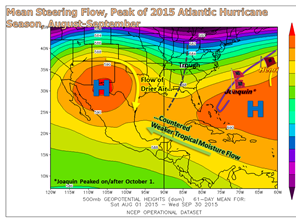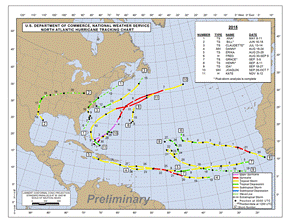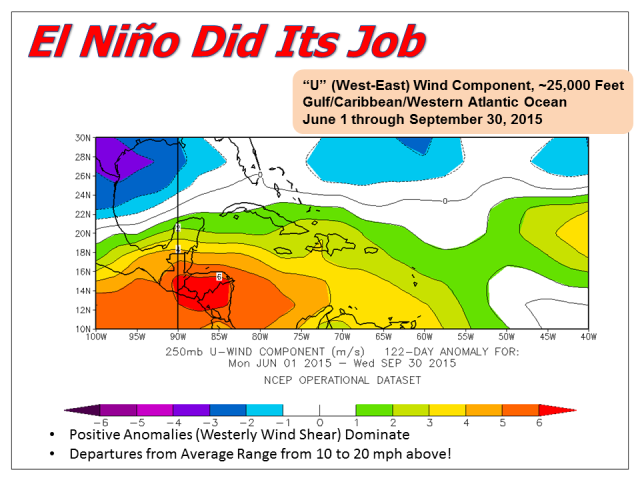| 2015 Atlantic Hurricane Season Review | |||||||||||||||||||||||||||||||||||||||||||||||||||||||||||||||||||||||||||||||||||||||||||||||||||
 Preliminary 2015 Hurricane Season tracks across the Gulf of America and western Caribbean Sea. Atlantic Basin: El Niño Did The Job Seasonal Forecast Spot On; Joaquin Big Story and Bill the Texas Story |
|||||||||||||||||||||||||||||||||||||||||||||||||||||||||||||||||||||||||||||||||||||||||||||||||||
|
Overview The season got off to a quick start, with Tropical Storm Ana setting an Atlantic Season record when making landfall near Myrtle Beach, SC, on May 10th! Ana was fed by unusually warm waters along the Southeast U.S. coast and the Gulf Stream. June featured the only cyclone to develop in the Caribbean or Gulf of America – Tropical Storm Bill – and even he was a struggling wave that was able to take advantage of a sliver of low wind shear and favorable moisture to quickly intensify to a 60 mph system before making landfall near Matagorda Island, TX, on June 17. Bill achieved tropical storm status 200 miles east of the King Ranch, but the Rio Grande Valley had no direct impacts with landfall. However, residual moisture left behind Bill’s circulation aided torrential rains and flooding from Hebbronville to Falfurrias on June 17/18. Torrential rains were by far the memorable impact from Bill in South Central Texas and Oklahoma, with millions in damage and two flood deaths in Oklahoma. The full report on Bill can be found here. The season’s first major (Category 3 wind) storm, August’s Hurricane Danny, was a "rags–to–riches–to–rags" story. Tiny Danny rapidly intensified to Category 3 over the open waters well east of the Leeward Islands, but after rising like a bullet he fizzled quickly, courtesy of El Niño’s robust high level wind shear and nearby dry air near the Islands; Danny soon dissipated with minimal impact. Tropical Storm Erika struggled to survive wind shear, but her source moisture combined with passage across the Leeward Islands in late August left perhaps the most devastating land damage of the entire season, with more than two dozen deaths and tens of thousands of homes flooded or washed away in floods and mudslides across Dominica. Erika’s moisture shield produced additional flooding across Puerto Rico and Hispañola. Fred formed quickly from a tropical wave just west of Guinea (Africa) at the end of August, and strengthened to a hurricane before reaching the Cape Verde Islands, a very rare event. Category 1 Fred prompted the first hurricane warnings in Cape Verde, and losses totaled more than $1 million – even though the rainfall was beneficial in a region that had been flirting with drought. Storm surge flooding inundated coastal Senegal (west Africa). The season's biggest story came a month later, when Category 4 Hurricane Joaquin exploded to life on October 1 from a tropical storm just 36 to 42 hours earlier (early on September 30). Joaquin ravaged the central and southern Bahamas on the 1st and 2nd, with hundreds of people trapped due to wind damage, storm surge, and rainfall flooding. Final data were unavailable as of this writing (see table below for preliminary values). The most devastating story from Joaquin was the sinking of the El Faro cargo ship, which left Jacksonville destined for San Juan, Puerto Rico, and was caught in the intensifying maelstrom over the central Bahamas. After seven days of searching, the U.S. Coast Guard called off the hunt; the wreckage was discovered in November. Thirty-three crew perished, making the sinking the single–most direct deadly event from the Atlantic season. Joaquin proved again that it only takes one cyclone to make a season, even if the season is quiet. Joaquin was the storm that found the proverbial "crack in the door" during a season fraught with wind shear and dry air. His motion to the southwest rather than the west placed the cyclone into a "pocket" of low wind shear, very warm ocean, and high moisture – the necessary ingredients for rapid strengthening. A plume of moisture from Joaquin energized a vigorous upper level disturbance that moved into South Carolina, enhancing rainfall to more than 24 inches in some locations and leaving more than $1 billion in damage. After Joaquin, the 2015 Atlantic Hurricane Season would wind down uneventfully, with late season Kate initially developing in the warm waters between the Southeast U.S. coast and Bermuda, and becoming a Category 1 hurricane well east of the mid Atlantic coast in mid November. Joaquin was not enough to turn the screws on the Accumulated Cyclone Energy Index, or ACE, which also ended up right in line with the forecast: 59 units, or a little over 63% of the average (93.2 units based on 1951 to 2000 data).  General steering patterns for the peak of the 2015 Hurricane Season (August to October; click to enlarge).  Preliminary 2015 Hurricane Season track, entire Atlantic basin (click to enlarge). |
|
||||||||||||||||||||||||||||||||||||||||||||||||||||||||||||||||||||||||||||||||||||||||||||||||||
 Fast Facts – Atlantic
Fast Facts – Pacific
|
|||||||||||||||||||||||||||||||||||||||||||||||||||||||||||||||||||||||||||||||||||||||||||||||||||
|
The following table summarizes the 2013 Atlantic Hurricane Season.
For final details on the 2015 Atlantic Hurricane Season, check the National Hurricane Center’s Atlantic Season Archive. Updates to the archive will be available through December and into 2016 as reports are generated and data are finalized. |
|||||||||||||||||||||||||||||||||||||||||||||||||||||||||||||||||||||||||||||||||||||||||||||||||||